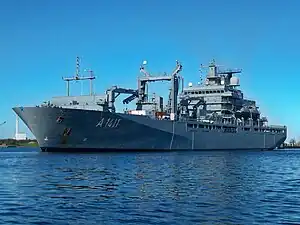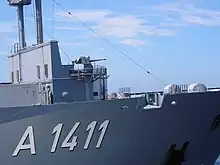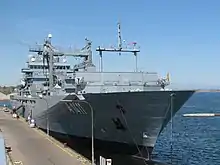Berlin-class replenishment ship
The Type 702 Berlin-class replenishment ship is a series of replenishment ships, originally designed and built for service in the German Navy (Deutsche Marine). Designed to support United Nations overseas missions, the Berlin class were initially to number four vessels. However, three hulls were cut from the initial order. The lead ship, Berlin, began construction in 1999 and entered service in 2001. The second hull, Frankfurt am Main, was re-ordered in 1998, began construction in 2000 and entered service in 2002. The third hull, Bonn, was ordered in 2008 to a modified design, began construction in 2010 and entered service in 2013. All three ships are in service and are based at Wilhelmshaven.
 Berlin | |
| Class overview | |
|---|---|
| Builders | |
| Operators |
|
| Preceded by |
|
| In commission | 2001–present |
| Planned | 6 |
| Building | 1 |
| Completed | 3 |
| Cancelled | 1 |
| Active | 3 |
| General characteristics | |
| Type | Replenishment oiler |
| Displacement | 20,240 t (19,920 long tons) |
| Length | 173.7 m (569 ft 11 in) |
| Beam | 24 m (78 ft 9 in) |
| Draught | 7.4 m (24 ft 3 in) |
| Propulsion |
|
| Speed | 20 knots (37 km/h; 23 mph) |
| Endurance | 45 days |
| Armament | |
| Aircraft carried | 2 × Sea King or NH90 helicopters |
| Aviation facilities | Hangar and flight deck |
The Berlin-class design was selected as the basis for the Royal Canadian Navy's (RCN) replacement for the two former Protecteur-class auxiliary oiler replenishment (AOR) vessels which were retired in 2014. Two Berlin-class variants, described as Joint Support Ships, were ordered by the RCN to be built in Canada. As of 2023, both vessels are under construction.
General characteristics

The Berlin-class replenishment ships are the largest vessels of the German Navy.[1] The Berlin-class replenishment ships are 173.7 metres (569 ft 11 in) long overall and 162 m (531 ft 6 in) between perpendiculars with a beam of 24 m (78 ft 9 in) and a draught of 7.4 m (24 ft 3 in). The vessels have a displacement of 10,115 tonnes (9,955 long tons) light and 20,243 t (19,923 long tons) at full load and measure 18,640 gross tonnage (GT). Constructed with a double hull, they have a pronounced bow bulb.[2] The ships have capacity for 9,000 m3 (320,000 cu ft)[2] or 7,600 t (7,500 long tons; 8,400 short tons)[3] of marine diesel fuel, 600 m3 (21,000 cu ft)[2] or 490 t (480 long tons; 540 short tons)[3] of aviation fuel, 60 m3 (2,100 cu ft)[2] or 126 t (124 long tons; 139 short tons)[3] of lube oil, 100 t (98 long tons; 110 short tons) of spare parts, 230 t (230 long tons; 250 short tons) of provisions and 195 t (192 long tons; 215 short tons) of ammunition,[2] or 71 t (70 long tons; 78 short tons) of fresh water, 100 t (98 long tons; 110 short tons) consumables, 1,075 t (1,058 long tons; 1,185 short tons) of supplies and 230 t of provisions.[3] The vessels have two replenishment at sea stations, one to each per side of the ship and two electro-hydraulic container and cargo cranes. The Berlin class have capacity for 86 TEUs of shipping containers and can stack 26 TEUs in two layers on the upper deck. The ships have provision for a Marineeinsatzrettungzentrum (MERZ) unit which is a modular operations rescue centre aboard the ship. The MERZ is capable of holding 50 patients and providing them with emergency surgery, intensive care, internal medicine and dental services.[2][4]
The first two vessels of the class, Berlin and Frankfurt am Main are powered by two MAN Diesel 12V 32/40 diesel-engines, creating 10,555 kilowatts (14,154 bhp) with two reduction gears turning two controllable pitch five-bladed propellers and powering one bow thruster.[2] Bonn creates 14,400 kW (19,300 hp).[3] They have four Deutz-MWM diesel generators. The three ships have a maximum speed of 20 knots (37 km/h; 23 mph) and have an endurance of 45 days.[2] The Berlin-class ships have a helipad aft and a hangar and can support two helicopters, either the Sea King or NH90 models which can be used for vertical replenishment.[2][5] The vessels are equipped with radar and mine avoidance sonar and one of the radars is situated aft for use during helicopter takeoff and landing.[2]
The Berlin class are armed with four MLG 27 mm (1.1 in) autocannon for anti-aircraft defence and four 12.7 mm (0.50 in) machine guns. The MLG 27 replaced older Bofors 40 mm (1.6 in)/70 guns. The vessels are also fitted for but not with Stinger surface-to-air missile (MANPADS) for point defence.[2] The vessels have a complement of 159 plus 74 embarked.[3][lower-alpha 1]
List of ships
| Image | Pennant number | Name | Laid down | Launched | Commissioned | Homeport | Status |
|---|---|---|---|---|---|---|---|
 |
A1411 | Berlin | 4 January 1999 | 30 April 1999 | 11 April 2001 | Wilhelmshaven | In active service |
 |
A1412 | Frankfurt am Main | 28 August 2000 | 5 January 2001 | 27 May 2002 | In active service | |
_(cropped).jpg.webp) |
A1413 | Bonn[7] | 16 September 2010 | 27 April 2011 | 13 September 2013 | In active service |
Construction and career
In 1994, the German Navy sought to construct four replenishment vessels, built in two batches.[2][5] The ships were designed to support United Nations operations overseas.[4] However, the project was trimmed to one and the design was finalised in mid-1996.[2][5] The first hull was ordered in October 1996. A second hull was authorized in June 1998. The hulls of the ships were built by Flensburger Schiffbau-Gesellschaft at their shipyard in Flensburg, Germany, with the electronic systems installed by Lürssen and the superstructure, final outfitting and sea trials done by Krögerwerft. The first ship, Berlin, completed construction in 2001 and was commissioned into the German Navy on 11 April 2001. The second vessel, Frankfurt am Main followed in 2002 and was commissioned on 27 May 2002.[2] The third ship, Bonn, was ordered on 3 December 2008 with increased power and accommodations and was built at Pennewerft in Wolgast.[2] On 13 September 2013, Bonn was commissioned into service at Wilhelmshaven.[6]
In 2007, Frankfurt am Main performed trials with Finnish 14 m (46 ft) Jurmo-class landing craft.[4] In 2020, Berlin operated with Standing NATO Maritime Group 2 (SNMG 2).[8]
Export
Royal Canadian Navy
Two ships will be procured to replace the two Protecteur-class vessels operated by the RCN until 2014 under the Joint Support Ship Project.[9] The ships will be built by Seaspan Marine Corporation at the Vancouver Shipyards facility located in North Vancouver, British Columbia.[9] The design was chosen over a design by BMT Technology. At the time, the option for a third was still possible.[10] Canadian sailors previewed Bonn in order to make themselves familiar with the design.[11]
The ships were originally to be named Queenston and Chateauguay, for battles from the War of 1812.[12] This decision was reversed in September 2017, when it was announced that the ships would perpetuate the names Protecteur and Preserver.[13] As of 2015 it was estimated that the two Canadian ships would cost C$2.6bn (~€1.75bn) to build, and a further C$4.5bn (~€3bn) to operate over 25 years.[14] The keel of the first ship was laid down on 16 January 2020.[15]
Citations
- "Berlin Class Fleet Auxiliary Vessels, Germany". naval-technology.com. Archived from the original on 20 May 2013. Retrieved 2 June 2013.
- Wertheim 2013, p. 239.
- Lürssen.
- Saunders 2009, p. 293.
- Sharpe 1996, p. 253.
- "Einsatzgruppenversorger "Bonn" in der Flotte angekommen". Archived from the original on 1 October 2013. Retrieved 13 September 2013.
- "Einsatzgruppenversorger Bonn schwimmt aus" (in German). German Navy. 12 May 2011. Archived from the original on 13 January 2016. Retrieved 11 February 2012.
- "German Navy's Berlin replenishment ship heading to Aegean Sea". Naval News. 2 April 2020. Retrieved 17 September 2020.
- "Backgrounder: Joint Support Ship Design". Public Works and Government Services Canada. 31 May 2013. Archived from the original on 14 May 2014. Retrieved 14 May 2014.
- "Feds pick off-the-shelf design for military resupply ships". CBC News. 2 June 2013. Archived from the original on 27 January 2014. Retrieved 13 May 2013.
- "German supply ship gives navy peek at new design". CBC News. 21 February 2014. Archived from the original on 4 March 2014. Retrieved 13 May 2014.
- "Minister Nicholson announces names for the Royal Canadian Navy's new Joint Support Ships". National Defence. 25 October 2013. Archived from the original on 14 May 2014. Retrieved 13 May 2014.
- "War of 1812 names for Joint Support Ships are history – Protecteur and Preserver are the new names". Ottawa Citizen. 12 September 2017. Archived from the original on 18 September 2017. Retrieved 19 September 2017.
- Auger, Martin (15 June 2015). "The National Shipbuilding Procurement Strategy: A Five-Year Assessment". Canadian Library of Parliament.
- Wilson, Carla (16 January 2020). "Ceremonial keel-laying held for new HMCS Protecteur". Times Colonist. Retrieved 18 January 2020.
References
- "EGV Type 702 (Berlin, Frankfurt, Bonn) Data Sheet". Lürssen. Retrieved 14 July 2021.
- Saunders, Stephen, ed. (2009). Jane's Fighting Ships 2009–2010 (112 ed.). Alexandria, Virginia: Jane's Information Group Inc. ISBN 978-0-7106-2888-6.
- Sharpe, Richard, ed. (1996). Jane's Fighting Ships 1996–97 (99 ed.). Surrey, United Kingdom: Jane's Information Group. ISBN 0-7106-1355-5.
- Wertheim, Eric, ed. (2013). The Naval Institute Guide to Combat Fleets of the World (16th ed.). Annapolis, Maryland: Naval Institute Press. ISBN 9-7-815911-4954-5.